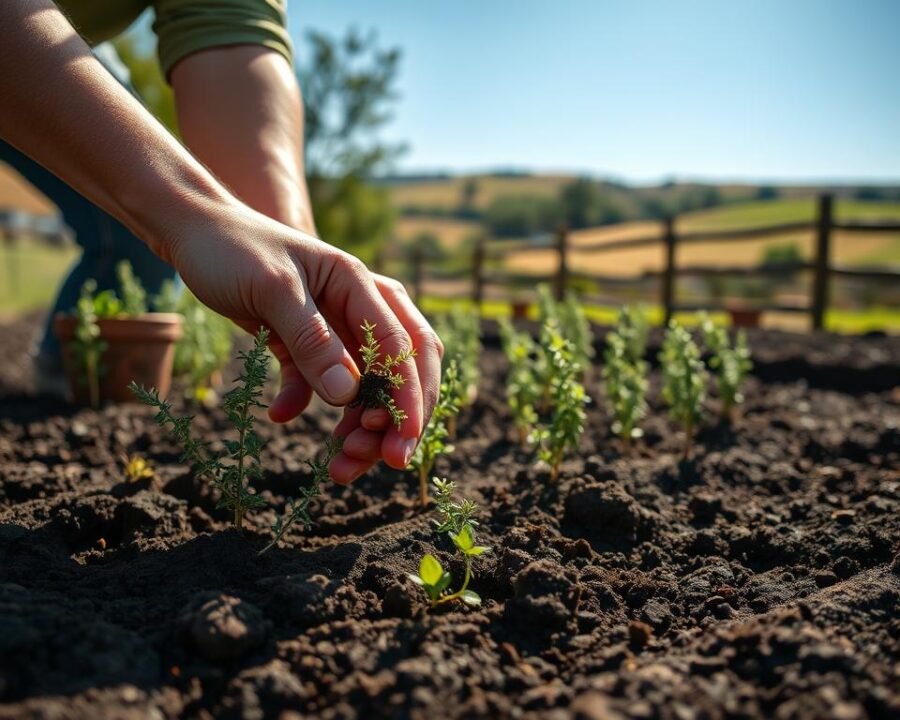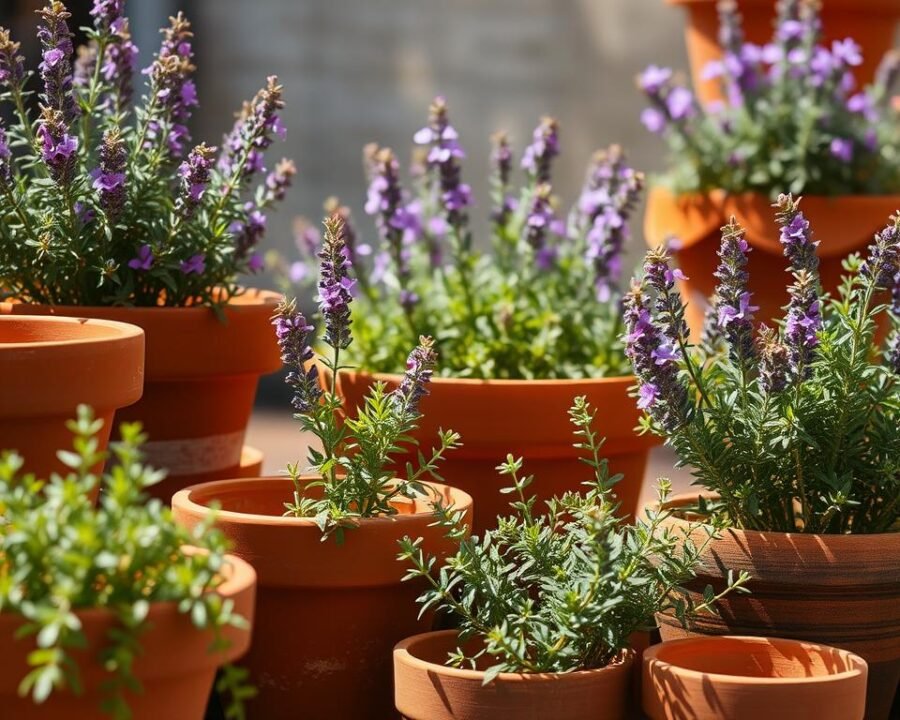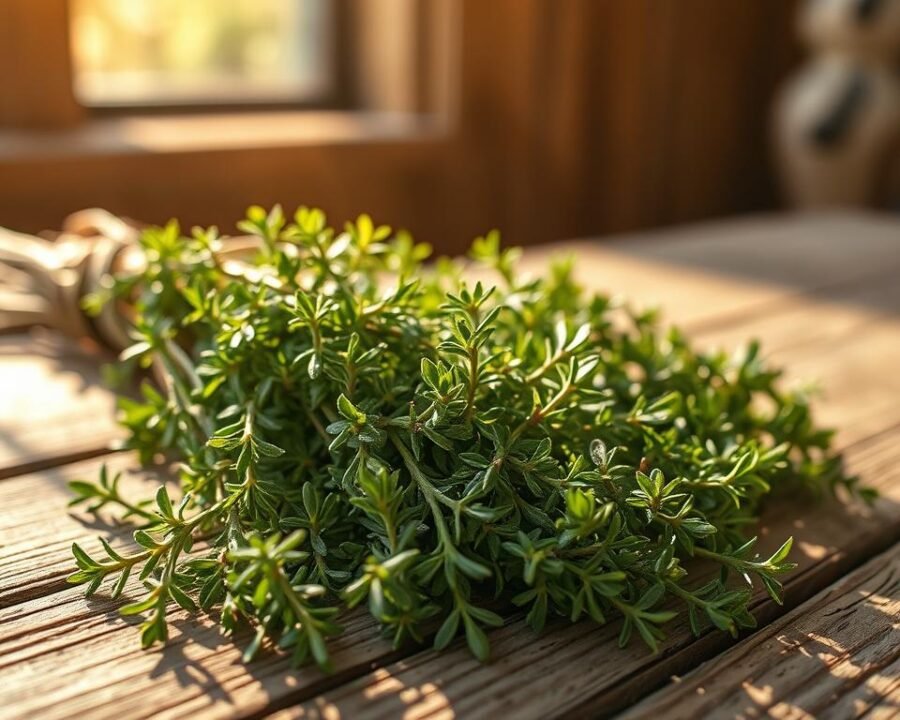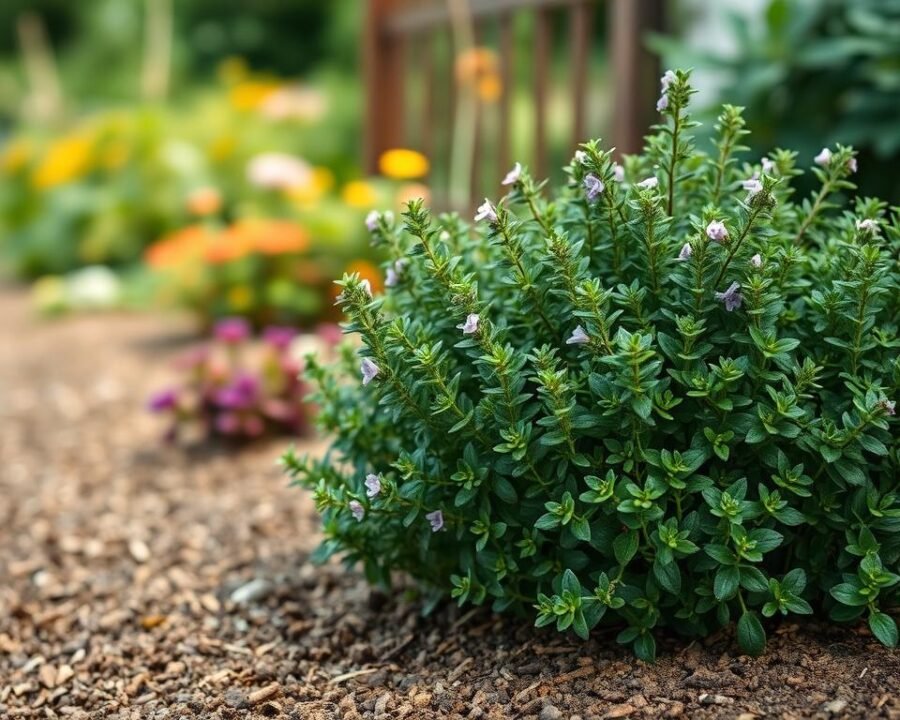There’s something magical about stepping into a garden filled with fragrant leaves and delicate blooms. Among the many choices, one standout is thyme—a versatile favorite in kitchens and landscapes alike. Whether sprinkled over roasted vegetables or lining a sunny garden bed, this hardy little plant brings both flavor and beauty.
With over 50 varieties, thyme offers endless possibilities. Its drought-resistant nature makes it perfect for dry climates, while its aromatic leaves and edible flowers add charm to any space. Best of all, you can harvest it year-round, ensuring fresh flavors whenever needed.
In this guide, we’ll explore expert-approved techniques to cultivate thriving plants. From selecting the right variety to mastering seasonal care, you’ll discover everything needed for success. Let’s dig in!
Key Takeaways
- Thyme is a resilient, aromatic herb with over 50 varieties.
- It thrives in dry conditions, making it low-maintenance.
- Both leaves and flowers are edible and fragrant.
- Year-round harvesting keeps your kitchen stocked.
- Proper selection and care ensure a flourishing garden.
Why Thyme Belongs in Your Herb Garden
Few plants blend beauty and utility as seamlessly as thyme. Whether nestled among vegetables or lining walkways, it elevates any garden with fragrance and function.
Creeping varieties release a soothing aroma when brushed against, making them ideal for pathways. Their low-growing habit adds texture to rock gardens or between stepping stones.
Beyond aesthetics, thyme shines in companion planting. It deters pests from cabbage and enhances the flavor of tomatoes. This natural partnership boosts yields while reducing chemical use.
- Pollinator magnet: Bees flock to its purple or white summer blooms, supporting local ecosystems.
- Evergreen appeal: In zones 5–9, it provides year-round greenery.
- Culinary star: Fresh or dried, its leaves enrich soups, roasted meats, and even preserves.
From cooking to curb appeal, thyme proves indispensable. Its adaptability and low-maintenance nature make it a must-have for any herb garden.
How to Grow Thyme Herb Plant Everyone Is Using
This resilient herb adapts to diverse climates, but success starts with smart choices. Picking the right variety and timing ensures lush growth and abundant harvests.
Choosing the Right Thyme Variety
Over 50 types exist, each with unique traits. Common thyme (Thymus vulgaris) suits culinary uses, while creeping varieties like Thymus serpyllum excel as ground cover.
Consider these factors:
- Flavor: Lemon thyme adds citrus notes to dishes.
- Hardiness: Woolly thyme thrives in rocky, dry soils.
- Climate: Check USDA zones for perennial vs. annual behavior.
| USDA Zone | Perennial/Annual | Recommended Varieties |
|---|---|---|
| 3–5 | Annual | German Winter, Caraway Thyme |
| 6–9 | Perennial | English, French, Lemon Thyme |
Ideal Planting Time for Your Climate
Timing depends on local frost dates and soil warmth. Planting too early risks damage, while late starts reduce growing time.
Spring is best for most regions after the last frost, when soil hits 70°F. In Arizona’s low desert, opt for October–April to avoid extreme heat.
For faster results, use transplants instead of seeds. They establish quicker and tolerate variable weather better.
Preparing the Perfect Environment for Thyme
A well-prepared environment unlocks thyme’s full potential in gardens and kitchens. This hardy herb thrives when given the right foundation—think well-drained soil, ample sunlight, and room to spread.
Soil Requirements and pH Levels
Thyme demands well-draining soil to prevent root rot. Sandy or rocky mixes mimic its native Mediterranean habitat. For containers, use a cactus blend or add perlite to standard potting soil.
Ideal pH ranges from 6.0 to 8.0. Test kits help adjust acidity with lime (to raise pH) or sulfur (to lower it).
“Poor soil is thyme’s best friend—overly rich mixes encourage leggy growth at the expense of flavor.”
Sunlight and Spacing Guidelines
Six hours of daily sun is non-negotiable. In scorching climates, afternoon shade prevents leaf burn. Here’s how light needs vary by region:
| Region | Sun Exposure | Spacing (inches) |
|---|---|---|
| Northern U.S. | Full sun | 12–18 |
| Southern U.S. | Morning sun + afternoon shade | 18–24 |
Proper spacing ensures air circulation, reducing fungal risks. Pair thyme with plants like rosemary or lavender for a drought-tolerant trio.
- Microclimates matter: South-facing walls reflect heat, boosting growth in cooler zones.
- Container depth: Opt for pots 8–12 inches deep with drainage holes.
Step-by-Step Planting Instructions
Getting thyme established requires attention to detail from the very start. Whether using transplants or seeds, proper techniques ensure robust growth and flavorful harvests.

Transplanting Young Thyme Plants
Transplants offer a head start, especially in shorter growing seasons. Begin by hardening off seedlings—gradually expose them to outdoor conditions over 7–10 days.
- Timing: Move transplants after the last frost when soil reaches 60°F.
- Spacing: Allow 12–24 inches between plants for air circulation.
- Depth: Match the pot’s soil level to avoid stem rot.
“Water transplants lightly for the first two weeks to encourage deep root development.”
Sowing Thyme Seeds Successfully
Starting from seeds demands patience but rewards with variety. Begin indoors 8–10 weeks before the last frost for a strong first year.
| Step | Details |
|---|---|
| Stratification | Chill seeds for 1 week to mimic winter. |
| Germination | Keep at 70°F with light soil covering. |
| Light | Use grow lights 14 hours daily. |
Expect sprouts in 14–28 days. Thin seedlings to prevent crowding, and transplant outdoors once they’re 3 inches tall.
Essential Care for Thriving Thyme
Healthy thyme depends on balanced care—too much love can harm as much as neglect. This hardy plant prefers a hands-off approach, thriving with minimal fuss. Focus on smart watering and strategic pruning to keep it lush and flavorful.
Watering Without Overdoing It
Thyme’s leaves store moisture, making it drought-tolerant. Overwatering leads to root rot, so let soil dry completely between sessions. In summer, water deeply once a week; in winter, reduce to monthly.
- Signs of thirst: Wilted or grayish leaves need a drink.
- Container tip: Use pots with drainage holes to prevent soggy soil.
Pruning Techniques for Bushy Growth
Regular trims prevent woody stems and boost growth. After the last spring frost, cut back up to one-third of the plant. Avoid pruning within a month of fall frost to protect new shoots.
“Sharp, clean shears prevent disease and ensure smooth cuts—wipe blades with rubbing alcohol between plants.”
For flowering varieties, prune after blooms fade to redirect energy. Non-flowering types benefit from light shaping every 6 weeks. The first year, focus on establishing structure before heavy harvesting.
Growing Thyme in Containers
Container gardening opens new possibilities for cultivating aromatic herbs in any space. Whether you’re short on yard space or want fresh flavors indoors, thyme adapts beautifully to pots. With a few smart choices, you’ll enjoy lush leaves and vibrant blooms all year.

Selecting the Right Pot and Soil Mix
Drainage is critical. Choose containers with holes—terra cotta or fabric pots work best. A 12-inch diameter ensures roots spread comfortably.
Use a gritty mix: combine potting soil with perlite or sand. This mimics thyme’s native conditions, preventing soggy roots. For indoor setups, the Twelve™ Indoor Growing System offers built-in aeration.
Indoor vs. Outdoor Container Care
Outdoor pots need six hours of sun. Rotate them weekly for even growth. In winter, insulate with bubble wrap or move to a sheltered spot.
Indoors, place near a south-facing window. Supplement with grow lights if leaves stretch. Keep humidity low—thyme dislikes muggy air.
- Light tips: Use timers for 14-hour cycles in darker months.
- Pest control: Wipe leaves with neem oil to deter mites.
- Seasonal moves: Shift pots outdoors after frost passes.
“Thriving in containers isn’t hard—just match its wild, rocky roots.”
Seasonal Maintenance Guide
Seasonal shifts bring unique needs for maintaining robust thyme plants. With simple adjustments, we keep this aromatic favorite flourishing through temperature swings and weather extremes.
Spring and Summer Care Tips
Warmer months demand vigilance against overgrowth and drought stress. Begin by removing winter mulch when frost risks pass. This prevents mold while letting soil warm.
In zones 3-5, replace annual varieties after the last spring freeze. For established plants, apply these practices:
- Prune strategically: Trim woody stems by one-third to encourage bushiness.
- Monitor moisture: Water only when topsoil dries completely.
- Check for pests: Spider mites thrive in heat—spray leaves with water if spotted.
“Summer blooms attract pollinators but can weaken flavor. For culinary thyme, pinch off flower buds as they form.”
Preparing Thyme for Winter
As fall arrives, shift focus to protection. Stop fertilizing six weeks before first frost to harden stems. In zones 6-9, mulch with pine boughs after ground freezes.
Container plants need special attention:
- Move pots: Shelter against south-facing walls or bring indoors.
- Prevent snow damage: Wrap shrubs in burlap where heavy accumulation occurs.
- Zone 10 tip: Treat as annual—replace plants each year for best results.
Watch for dormancy cues like slowed growth. This signals time to reduce watering until spring.
Common Thyme Problems and Solutions
Even the hardiest herbs face challenges, and thyme is no exception. While resilient, it can fall victim to root rot, fungal infections, or pesky insects. Catching issues early ensures your plants stay lush and productive.
Preventing Root Rot and Fungal Issues
Soggy soil is thyme’s worst enemy. Overwatering or poor drainage invites root rot—a silent killer. Let soil dry completely between sessions, especially in humid climates.
- Improve drainage: Mix sand or gravel into garden beds.
- Fungal signs: Yellowing leaves or blackened stems.
- Companion help: Plant near rosemary to boost airflow.
“Fungus thrives in stagnant air. Space plants 12+ inches apart and avoid wetting leaves when watering.”
Managing Pests Like Spider Mites
Spider mites love heat and dry conditions—ironically, thyme’s preferred habitat. These tiny pests suck sap, leaving speckled or wilted foliage.
| Pest | Organic Solution | Chemical Alternative |
|---|---|---|
| Spider Mites | Blast with water spray; introduce predatory mites | Neem oil (weekly applications) |
| Aphids | Ladybugs or soap spray | Pyrethrin-based sprays |
For severe infestations, quarantine affected plants immediately. Regular inspections under leaves help catch pests before they spread.
Harvesting Thyme for Maximum Flavor
Timing and technique make all the difference when gathering this aromatic favorite. With the right approach, we ensure vibrant growth while enjoying nature’s bounty at its peak.
Best Time to Pick Leaves
Early morning is ideal—essential oils concentrate in leaves after dew evaporates. For the richest flavor, harvest just before flowering begins in early summer.
- Seasonal peaks: Spring offers tender new stems, while fall provides robust flavor before dormancy.
- Frequency: Light trims every 3-4 weeks maintain productivity without stressing the plant.
- Flowering note: Blooms attract pollinators but can mute taste. For culinary use, trim buds as they form.
Proper Cutting Techniques
Sharp, clean tools prevent damage. We recommend bypass pruners or micro-tip scissors for precision.
| Stem Type | Cutting Method | Result |
|---|---|---|
| Green stems | Snip ¼ inch above leaf nodes | Encourages bushier regrowth |
| Woody stems | Cut back to 2-3 inches of new growth | Revitalizes older plants |
“Always leave at least two-thirds of the plant intact—overharvesting weakens future production.”
For propagation, select healthy 4-inch stems with multiple nodes. Remove lower leaves and place in water until roots develop.
- Angle cuts: 45-degree slices shed water and heal faster
- Post-harvest care: Water lightly and avoid fertilizing for a week
- Storage tip: Refrigerate fresh sprigs in damp paper towels for up to 10 days
Preserving and Using Your Thyme
Preserving thyme unlocks year-round flavor for all your culinary creations. Whether dried, frozen, or infused, this herb retains its aromatic punch long after harvest. Let’s explore the best methods to savor its taste in every season.

Drying, Freezing, and Storing Methods
Each preservation technique highlights thyme’s unique qualities. Air-drying intensifies earthy notes, while freezing captures fresh brightness.
| Method | Steps | Shelf Life |
|---|---|---|
| Air-Drying | Bundle stems; hang upside-down in a dark, dry place for 1–2 weeks | 1 year |
| Freezing | Strip leaves into ice cube trays, cover with olive oil or water | 6 months |
| Infused Oil | Steep sprigs in warm oil for 30 minutes, strain, and refrigerate | 1 month |
“Dried herbs pack more punch—use half the amount of fresh in recipes.”
Culinary Uses for Fresh and Dried Thyme
Thyme’s flavor pairs beautifully with diverse ingredients. Lemon thyme brightens seafood, while classic varieties deepen stews and roasts.
- Perfect pairings: Garlic, tomatoes, honey, or mushrooms.
- Fresh vs. dried: 1 tbsp fresh = 1 tsp dried.
- Unexpected twists: Muddle into gin cocktails or steep in tea.
For compound butter, blend minced leaves with softened butter and a pinch of salt. Spread over warm bread or melt over grilled vegetables.
Conclusion
From garden beds to gourmet dishes, thyme delivers rewards all year. Its drought tolerance and rich flavor make it a standout among plants.
Experiment with varieties—lemon for zest, creeping for ground cover. Each brings unique charm to landscapes and meals.
Share your favorite herb-infused recipes or growing tips. Whether in pots or plots, thyme thrives with simple care and patience.
Ready to start? Grab a trowel and let this versatile thyme shine in your space!
